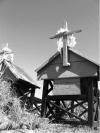Abstract
AbstractThe Araucania, located to the south of Chile, is one of the territories which owns greater cultural diversity as a result of thecolonization process that gave a hallmark to this zone at the end of xix century. This can be appreciated in different manifestations;most of them find their maximum expression through architecture, which reflect a complex reality full of rites, sentimentalismand traditions as European as Chilean or Mapuche, that mix together in a multiethnic landscape. Old stations, historicalneighbourhoods, forgotten country estates and peculiar cemeteries constitute the mentioned sceneries, and these are therichest ones, capable of synthesizing the relationships among several societies which manage to be united reaching a culturalsyncretism that should be understood as a the Arauncania’s distinctive. This bond with the space, the relationship with theenvironment and the modification of this, have generated, that in this 127 years of immigration, exist a permanent dialoguethat can go beyond the time through social residual spaces, which are valuable sources to rebuild the history and understandthe construction of one of the most heterogeneous territories of South America. CApuntes is registered under a Creative Commons Attribution 4.0 International Public License. Thus, this work may be reproduced, distributed, and publicly shared in digital format, as long as the names of the authors and Pontificia Universidad Javeriana are acknowledged. Others are allowed to quote, adapt, transform, auto-archive, republish, and create based on this material, for any purpose (even commercial ones), provided the authorship is duly acknowledged, a link to the original work is provided, and it is specified if changes have been made. Pontificia Universidad Javeriana does not hold the rights of published works and the authors are solely responsible for the contents of their works; they keep the moral, intellectual, privacy, and publicity rights.
Approving the intervention of the work (review, copy-editing, translation, layout) and the following outreach, are granted through an use license and not through an assignment of rights. This means the journal and Pontificia Universidad Javeriana cannot be held responsible for any ethical malpractice by the authors. As a consequence of the protection granted by the use license, the journal is not required to publish recantations or modify information already published, unless the errata stems from the editorial management process. Publishing contents in this journal does not generate royalties for contributors.

